Here are more details to expand on Terrazas’ original post.I thought I would share a great success story we’ve had with our Hex Map Board and the resulting 3 mods we made to the core Mage Wars system. We have play tested these mods dozens and dozens of times with 5 experienced players over the course of nearly a year and we’ve never looked back. We very rarely play 2-player any more, mostly 3-player or team play with a few 4-player free-for-alls thrown in.
(1) Hex Board
(2) Walls at zone corners block Line of Sight (LoS)
(3) 3-Player Cut Throat Games get 130 vs. 120 Points
(4) 4-Player Cut Throat Games get 140 vs. 120 Points
MOD #1 (Hex Board) - THE MAP BOARD AND SETUP:Map board consists of 37 hexagonal zones, each approximately 8 inches wide from edge to edge. In its current iteration the map board fits on a 50in square table.
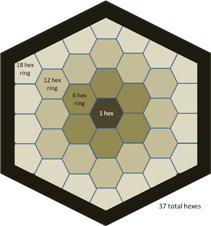
2-player configuration: Mages start in opposite corners and exclude the left/right edges from play (map board narrows). This ensures each mage starts 6 zones away to meet the spirit of the original game design.
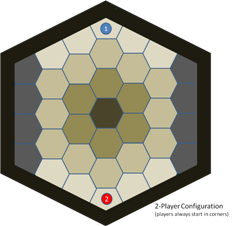
3-player configuration: Mages start in corners with one corner vacant between each player. This ensures each mage starts 6 zones away to meet the spirit of the original game design.
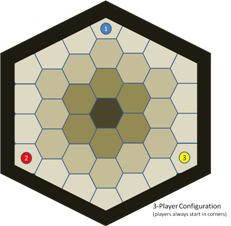
4-player configuration: 2 mages start in opposing corners. 3rd and 4th mage start in edge zone 4 zones away from one mage and 5 zones away from the other. Each mage must start 4 zones away from 1st opponent, 5 zones away from 2nd opponent, and 6 zones away from 3rd opponent. This configuration ensures no mage has a disadvantage over their opponents.
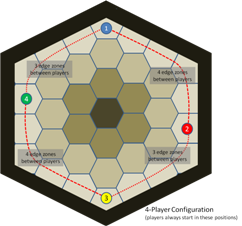
4-player team configuration: Each team starts on a map edge opposing the opposite team. The team mages can start in any of the 4 zones on their edge to include starting in the same zone.
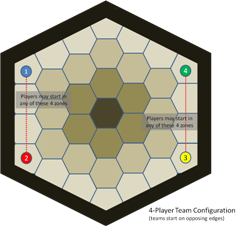
Game play proceeds as per the official rules. Exceptions are the MOD #2 Rule regarding LoS on a hex map board, and when applicable MOD #3 or MOD #4 when playing cut throat.
MOD #2 (Walls at zone corners block LoS):This was necessary because a hex zone offers 6 vs. 4 sides. Our Goals with this mod:
(a) ensure walls continue to be an effective component of the game using hex zones
(b) do not adversely affect LoS determination
To ensure walls could still be effective we elected to modify the MW rules to permit a wall to block LoS at the corners (zone edge corners). LoS is still determined from zone center but if that line crosses a zone corner with a wall on any connecting edge then Los is blocked. This rule mod has proven very effective and achieved all our goals.
MOD #3 (3-Player Cut Throat Games get 130 vs. 120 Points):We immediately began playing 3-player on the new hex map board using the standard 120 point builds for Spell Books. However, the strategies used in a 3-player game of cut throat are very different than a 2-player or even team play. A player needs to be wary of finding themselves in a 2 on 1 situation. The end result is either a very fast game for one player or a very long game for all players. As time progressed and our experience with Mage Wars improved we found that longer 3-player games were becoming the norm. This typically meant that we found our 120 point Spell Books did not quite provide the diversity nor quantity of spells necessary to have competitive games. We recently increased the limit to 130 points and this has worked well so far (more play testing needed).
MOD #4 (4-Player Cut Throat Games get 140 vs. 120 Points):4-Player Cut Throat play is very much like 3-Player Cut Throat only much more dangerous. Diversity and quantity of spells is essential since you now face more and wider variety of foes. Games definitely last longer as the risk of premature aggressive action can easily lead to a 2-on-1 or even 3-on-1 situation. We quickly realized that 120 point Spell Books would not do and increased the limit to 140 points. We have played tested this several times and the new limit appears to be just right.
NOTE: 4-Player Team Play did not have this challenge. After dozens of team games, we have not seen a need to adjust the limit from the standard 120 point Spell Books.COMMENTS ON MULTI-PLAYER GAME EXPERIENCE:We thoroughly enjoy playing Mage Wars with more than 2 players. 2 player games have become rare and 4-player Team play seems to be the most enjoyable.
Team play games are usually the most fun and on average seem to go slightly faster than 2 player. Once one mage dies, if the opposing teams mages aren’t badly hurt then the game is called as the single mage team has little hope of winning. Having an ally allows for interesting mage-mage combos and actions taken by one mage to directly support another (e.g. enchanting your team mate, or teleporting your teammate into/out of harms way). It is also fun to watch a team melt down when players forget their acting as a team and try to go solo or take some action unexpected by their team mate.
3-player and 4-player cut throat are the most exhilarating with everyone on edge throughout the game (loads of taunting and negotiating for temporary alliances). These often last 4+ hours though; our last 3-player game was so evenly matched that it lasted over 8 hours and had to be called a draw due to player exhaustion.
6-Player Team Play, we would love to give this a try if/when we recruit a 6th player into our group. 2 teams of 3 mages or 3 teams of 2 mages should prove to be very challenging and enjoyable. I suspect these will be very long games though, but then again, so many mages on the board may force confrontations early.
5-Player – WHAT?!?!?! Our group of 5 would love to give this a go but we haven’t figured out a way to make it happen. There is no simple, fair way to bring 5 mages into a hex or square arena and I am NOT going to design a pentagonal or decagonal map board.
HISTORY OF THE HEX MAP BOARD:Why do this? I never liked playing tactical games on a map board consisting of square zones. The hex is a time-proven method to bring a bit more realism to a 2 dimensional game board.
Size matters: In designing the board, I wanted to ensure it did not get so big as to be unwieldy and yet have sufficient number of zones to attempt to adhere to the original game design (each mage begins 6 zones from their opponent). An additional constraint was to ensure each hex zone was sized sufficiently to hold 2 cards end-to-end (approximately 8 inches). With these constraints in mind, the map board consists of 37 hexagonal zones, each about 7.5 inches wide from edge to edge. In its current iteration the map board fits on a 50 inch square table.
How to create a large hex? This is not as easy as one might think. It is frustratingly difficult to achieve a perfect 60 degree angle 6 times! Templates exist but these are for smaller hexes. I wanted hexes that measured nearly 8 inches from edge to edge. I tried to design a template on the computer but all angles were not a perfect 60 degrees when printed. I tried using a protractor but could never manage to get the angles consistently right 6 times out of 6. The template imperfections meant I had to figure a way to hide my mistakes. I elected to use wide borders as a means to cover up my lack of skills. My most recent iteration used a different technique using thread which I will describe later.
How to transport/store this large hex map board? This was a challenge from the very beginning and has undergone 4 iterations to reach its final state.
Iteration #1 (The Great Puzzle): The first idea, and the most complex, was to have the hexes be interlocking tiles. The vision was a great puzzle that we could assemble and break-down quickly. I knew going in that I did not have the skills or tools to do this perfectly so I envisioned using foam that could compress and help lock the individual zones together. I purchased 1/8 inch thick foam sheets, and cut-out the hexes with notched edges so they could interlock like a puzzle to an adjoining zone. This idea proved very difficult and the results were not impressive. It is not easy to create a single large hex, and even more difficult to create 37 of them with sufficient accuracy to align together without any noticeable imperfections. Add in the interlocking component and you quickly have a mess. No two pieces were exactly the same so figuring out how best to assemble the board between games proved to be too arduous. The end result was also too large to fit nicely on my 53 inch square kitchen table. This version just would never work and was abandoned without a game played.
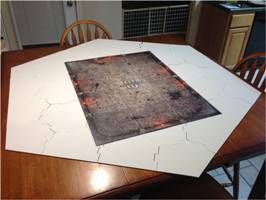
IMAGE OF ITERATION #1
Iteration #2 (The Great Puzzle gets a Make-Over and Glue Down): The next idea was to abandon the tear-down nicety of the Great Puzzle and make one large fixed board. I glued the puzzle pieces down to a thick 1/2 inch foam board) and added some texture. The texture consisted of 37 hex images of dark stone tiles glued onto the individual hexes. After the glue set then whole board was given a coating of Mod Podge and the board had a nice semi-smooth shiny sheen! This version worked very well for many games but proved very difficult to transport and store. The thick inflexible board was over 4 feet wide so a new version was needed.
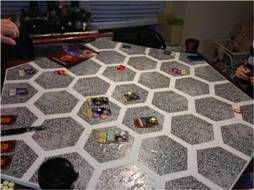
IMAGE OF ITERATION #2
Iteration #3 (Thin and Flexible): Taking the ideas from my first two iterations, I printed out 37 hexes using a nice brown tile pattern. Since I couldn’t find 50 in x 50 in sheets of poster board, I patch worked several sheets of poster board to form one large surface and glued the hex paper sheets to it. Then I continued to glue additional poster board sheets to the first and so on to form a plywood-like board of 4 layers of poster board. The whole map board was trimmed into a great hex and then Mod Podged for durability and sheen. This version worked very well and is still used today. However, while flexible enough to be bent and stuffed in the back of a car, this version still had storage challenges. Something even better was needed.
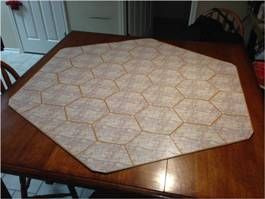
IMAGE OF ITERATION #3
Iteration #4 (Vinyl Baby): I just happened to wonder into a Jo Anne’s Fabrics and discovered I could buy vinyl that was 50 inches wide and in whatever length I wanted. 50 inches just happened to be the exact width of my Mage Wars hex board; who would have thunk it! A vinyl map board could be rolled up which solves both my transportation and storage problems. Vinyl also comes in a variety of colors and textures and is very easy to clean should something get spilled. So I bought enough to make a couple 50 inch map boards and proceeded to draw my design on the vinyl using a pencil. The thought behind the pencil was so I could make mistakes before I used my permanent Sharpie to finish the design. Unfortunately pencil does not draw well on vinyl which led me to take the risk and shift directly over to the Sharpie. I somehow forgot my bitter lessons: (a) how difficult it is to create a large hex, (b) my creative cover-up idea of using wide borders, (c) you cannot erase mistakes from a Sharpie. Well needless to say both vinyl sheets are now FUBAR. I tried again with a 3rd sheet but this time I also bought some white thread. I taped down parallel lengths of thread across the vinyl at precise distances from one another. I repeated this at 60 degree angles until I had a grid across the vinyl sheet. The intersections of the threads showed me where the hexes needed to be drawn. Now I carefully used my Sharpie and a straight edge to draw directly over the thread for each hex edge I wanted on the vinyl. Threads removed and I have a very nice and reasonable precise hexagonal map board on vinyl – woo hoo! While not as aesthetically pleasing as Iteration #2 or Iteration #3, this very smooth map board is much more playable and our group thinks it is the best version yet. There’s bound to be artistry added or even another iteration to bring the aesthetics back.
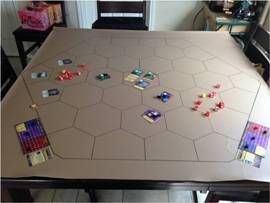
IMAGE OF ITERATION #4
Well that about sums it all up – Mage Wars is a great game and even better on a hex board.

